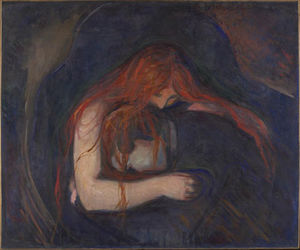
|
| ©Munch |
| Vampire |
Beliefs about spirits coming in the night to eat the flesh of the living were pervasive among early New Englanders, and may have inspired the creator of Dracula -- and fear of blood-sucking vampires lurking in the night.
Although it is unlikely that the early settlers of Connecticut, Rhode Island, Vermont and New Hampshire used the term "vampire," historical evidence shows rampant belief in the undead.
Unlike modern interpretations involving imposing castles, pale faces and menacing bats, vampires that were perceived to lurk in the backwoods and farmlands of Connecticut looked more like malnourished farmers.
"We have found evidence of a vampire folk belief throughout New England," said Nicholas Bellantoni, Connecticut's state archaeologist. "The accounts we have documented have primarily shown up in rural areas, with hot spots in eastern Connecticut and western Rhode Island."
The fears may have been stoked by an outbreak of tuberculosis, which caused extreme abdominal pain, particularly at night when lying down. Some victims bled from their mouths, said Michael Bell, a Rhode Island author and folklore expert.
Tuberculosis was the leading cause of death in 19th-century New England, accounting for 25 percent of all deaths at the time, Bell said.
Although there were reports of unearthing the dead because of fears of vampires in Chicago, northern Pennsylvania and upstate New York, the folklore is rooted in New England, Bell said.
People did not understand germs or the disease, or how it spread, Bellantoni said.
"The idea of the undead was used to explain the epidemic death," he said.
About two dozen cases of what could be considered vampirism were reported in five New England states from about 1784 to 1892, Bell said.
"When these family members died and other people began to suffer similar symptoms, some people believed the people who died could spread the disease," Bellantoni said. "People were dying and had no way to explain why."
Bellantoni compared this spread of tuberculosis with diseases that are not understood today.
"These people were frightened and trying to save loved ones. They were willing to do whatever was necessary to save their lives," he said.
It is more than coincidence that the vampires the farmers feared share traits with Bram Stoker's "Dracula," he said.
"Stoker had newspaper articles of New England and New York cases," Bellantoni said. "He was collecting evidence on the undead from around the world."
All the documented cases in New England occurred outsidethe Puritan heartland of Massachusetts and central and western Connecticut, Bell said. They took place in "fringe" areas where folk practices migrated from Eastern Europe, he said.
Dr. Michael Parry, director of infectious diseases and microbiology at Stamford Hospital, said tuberculosis, a highly contagious respiratory illness, is almost always spread through droplets in the air. It usually travels to the lungs and battles the immune system for about two weeks. It could become dormant for decades before flaring up again when the immune system weakens.
Victims primarily had severe cough, fever and weight loss.
"As the illness progresses, the cough could become bloody and include chest pains," Parry said. "It goes on for months and months and becomes increasingly worse."
A victim might develop nightmares or delusions from the fever, and leave blood on their bed linens from coughing -- things that some believed were caused by vampires.
Bell studied one victim in southeastern Connecticut known as JB who is believed to have died between 1820 and 1840 in Griswold near the Rhode Island border.
"On the lid of the hexagonal, wooden coffin, an arrangement of brass tacks spelled out 'JB-55,' presumably the initials and age at death of this individual," Bell wrote in his book, Food for the Dead: On the Trail of New England's Vampires. "When the grave was opened, JB's skull and thigh bones were found in a skull and crossbones pattern on top of his ribs and vertebrae, which was also rearranged."
Bell and Bellantoni concluded the grave was opened five to 10 years after JB's death and his bones rearranged with the hope of preventing his spirit from terrorizing the village.
"We do find certain references, about 22, that mention this going on," Bellantoni said. "One is from a doctor. He was outraged people were going into the graves. He . . . wrote an article in the local newspaper saying this should not be done."
Two brothers, Elisha and Lemuel Ray, also in Griswold, were exhumed and burned in the hope of saving the life of their brother, Henry Ray, in 1854, though he died months later.
People sometimes dug up a person they suspected was a vampire, burned the heart and fed the ashes to a victim, Bell said. In other cases, they burned the entire body and had the victim inhale the ashes. Most people avoided speaking about the taboo practice.
Similar cases were reported in West Stafford, Conn.; Exeter, West Greenwich, Foster and Cumberland, R.I.; Plymouth, Mass.; Barnstead and Loudon, N.H.; and Woodstock, Manchester and Dummerston, Vt.
"We do know it was going on," Bellantoni said. "These are probably not families who want to do this but are doing it as a last resort to save a loved one."
After the publication of Dracula in 1897, vampire rituals seemed to stop, he said.
"Two things, I think, are happening," he said. "In the late 1880s, you're getting a more medical answer where there's a scientific approach and information of how to deal with the disease, and once Dracula addresses it, it becomes a huge social stigma."



Comment: There is a better solution to this mystery. See: Alien Abduction, Demonic Possession and The Legend of the Vampire.